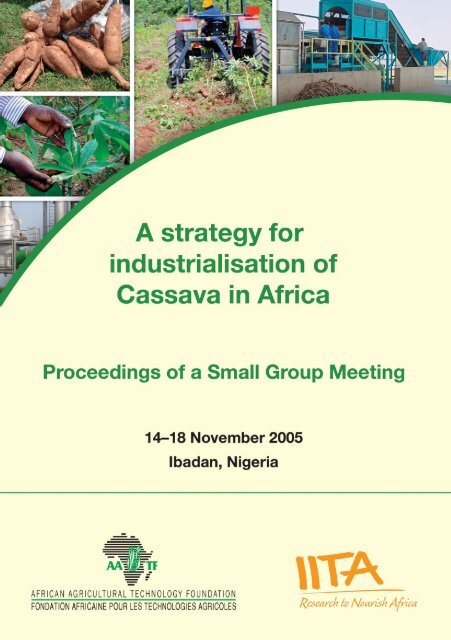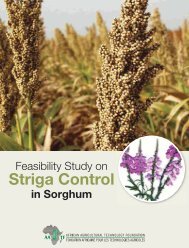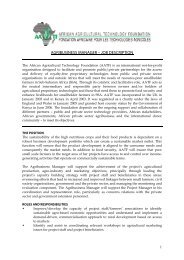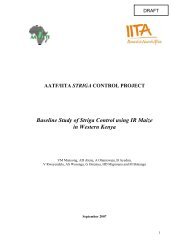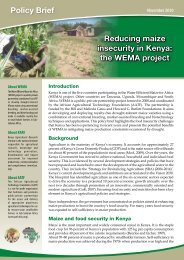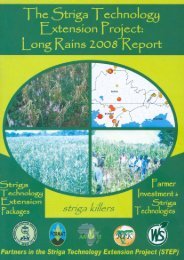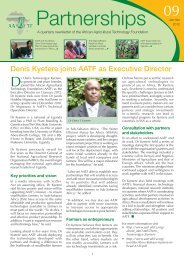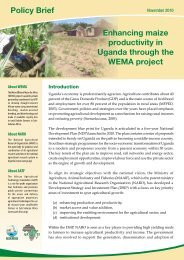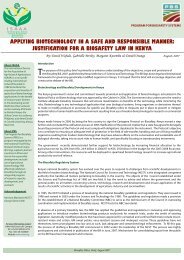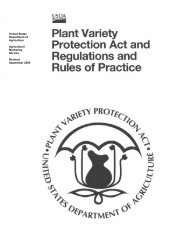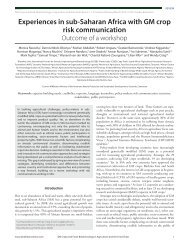A strategy for industrialisation of cassava in Africa - African ...
A strategy for industrialisation of cassava in Africa - African ...
A strategy for industrialisation of cassava in Africa - African ...
You also want an ePaper? Increase the reach of your titles
YUMPU automatically turns print PDFs into web optimized ePapers that Google loves.
PROCEEDINGS OF A SMALL GROUP MEETING, 14–18 NOVEMBER 2005, IBADAN, NIGERIA<br />
A <strong>strategy</strong> <strong>for</strong><br />
<strong><strong>in</strong>dustrialisation</strong> <strong>of</strong><br />
<strong>cassava</strong> <strong>in</strong> <strong>Africa</strong><br />
Proceed<strong>in</strong>gs <strong>of</strong> a Small Group Meet<strong>in</strong>g<br />
14–18 November 2005<br />
Ibadan, Nigeria<br />
i
A STRATEGY FOR INDUSTRIALISATION OF CASSAVA IN AFRICA<br />
Citation<br />
Nang’ayo F, Omanya G, Bokanga M, Odera M, Muchiri N, Ali Z and Werehire P. (eds).<br />
A <strong>strategy</strong> <strong>for</strong> <strong><strong>in</strong>dustrialisation</strong> <strong>of</strong> <strong>cassava</strong> <strong>in</strong> <strong>Africa</strong>: Proceed<strong>in</strong>gs <strong>of</strong> a small group<br />
meet<strong>in</strong>g, 14–18 November 2005, Ibadan, Nigeria. Nairobi, Kenya: <strong>Africa</strong>n Agricultural<br />
Technology Foundation<br />
© <strong>Africa</strong>n Agricultural Technology Foundation 2007<br />
All rights reserved<br />
The publisher encourages fair use <strong>of</strong> this material provided proper citation is made<br />
Design & Layout: Support <strong>for</strong> Development Communication, PO Box 27628-00506,<br />
Nairobi, Kenya<br />
Photographs: AATF<br />
Pr<strong>in</strong>t<strong>in</strong>g:<br />
Acknowledgements<br />
The AATF gratefully acknowledges the assistance <strong>of</strong> all people, participants and partner<br />
<strong>in</strong>stitutions who made the event a success and compilation <strong>of</strong> this report possible.<br />
Special thanks to Drs Alfred Dixon and Sani Lateef <strong>of</strong> IITA, Ibadan <strong>for</strong> logistical assistance<br />
<strong>in</strong> plann<strong>in</strong>g this workshop and AATF staff <strong>for</strong> the logistical support.<br />
ii
PROCEEDINGS OF A SMALL GROUP MEETING, 14–18 NOVEMBER 2005, IBADAN, NIGERIA<br />
Contents<br />
List <strong>of</strong> abbreviations<br />
Preface<br />
v<br />
vi<br />
Introduction 1<br />
Analysis <strong>of</strong> the status <strong>of</strong> the ethanol sub-sector <strong>in</strong> Nigeria<br />
Background 4<br />
Discussion <strong>of</strong> issues 5<br />
Analysis <strong>of</strong> the status <strong>of</strong> the starch sub-sector <strong>in</strong> Nigeria<br />
Background 8<br />
Discussion <strong>of</strong> issues 9<br />
Analysis <strong>of</strong> the status <strong>of</strong> <strong>cassava</strong> food sub-sector <strong>in</strong> Nigeria<br />
Background 11<br />
Discussion <strong>of</strong> issues 13<br />
Analysis <strong>of</strong> the status <strong>of</strong> <strong>cassava</strong>-based livestock feed sub-sector <strong>in</strong> Nigeria<br />
Background 15<br />
Discussion <strong>of</strong> issues 16<br />
Analysis <strong>of</strong> potential <strong>for</strong> large scale production <strong>of</strong> <strong>cassava</strong> <strong>in</strong> Nigeria<br />
Background 18<br />
Discussion <strong>of</strong> issues 18<br />
Policy options and potential <strong>for</strong> entrepreneurship <strong>in</strong> <strong>cassava</strong> production and<br />
<strong><strong>in</strong>dustrialisation</strong> <strong>in</strong> Nigeria<br />
Background 20<br />
Discussion <strong>of</strong> issues 20<br />
Summary and recommendations 21<br />
List <strong>of</strong> participants 23<br />
iii
A STRATEGY FOR INDUSTRIALISATION OF CASSAVA IN AFRICA<br />
List <strong>of</strong> abbreviations<br />
AATF<br />
CGIAR<br />
DDG<br />
EPA<br />
FAO<br />
HACCP<br />
HQCF<br />
IFAD<br />
IFDC<br />
IITA<br />
ISO<br />
ISTRC-AB<br />
NAFDAC<br />
NEPAD<br />
NIYAMCO<br />
NSM<br />
RF<br />
SMEs<br />
USAID<br />
<strong>Africa</strong>n Agricultural Technology Foundation<br />
Consultative Group on International Agricultural Research<br />
Distillers dry gra<strong>in</strong>s<br />
Environmental Protection Agency<br />
Food and Agriculture Organisation <strong>of</strong> the United Nations<br />
Hazard analysis and critical control po<strong>in</strong>t<br />
High quality <strong>cassava</strong> flour<br />
International Fund <strong>for</strong> Agricultural Development<br />
International Fertilizer Development Centre<br />
International Institute <strong>of</strong> Tropical Agriculture<br />
International Organisation <strong>for</strong> Standardisation<br />
International Society <strong>for</strong> Tropical Root Crops-<strong>Africa</strong> Branch<br />
National Agency <strong>for</strong> Food and Drug Adm<strong>in</strong>istration and Control<br />
New Partnership <strong>for</strong> <strong>Africa</strong>n Development<br />
Nigerian Yeast and Alcohol Manufactur<strong>in</strong>g PLC<br />
Nigeria Starch Mills<br />
The Rockefeller Foundation<br />
Small and medium enterprises<br />
United States Agency <strong>for</strong> International Development<br />
iv
PROCEEDINGS OF A SMALL GROUP MEETING, 14–18 NOVEMBER 2005, IBADAN, NIGERIA<br />
Preface<br />
The current high cost <strong>of</strong> <strong>cassava</strong> production and low quality <strong>of</strong> <strong>cassava</strong> products <strong>in</strong><br />
<strong>Africa</strong> stems from <strong>in</strong>efficient traditional production and process<strong>in</strong>g methods, which<br />
severely limit the ability <strong>of</strong> the cont<strong>in</strong>ent to enter local and export <strong>in</strong>dustrial markets<br />
and effectively compete with corn starch <strong>in</strong> global markets. For <strong>cassava</strong> to play a role<br />
<strong>in</strong> the economic growth <strong>of</strong> <strong>cassava</strong> produc<strong>in</strong>g countries <strong>in</strong> <strong>Africa</strong>, an <strong>in</strong>tegrated approach<br />
comb<strong>in</strong><strong>in</strong>g large <strong>in</strong>vestments <strong>in</strong> <strong>in</strong>dustries us<strong>in</strong>g <strong>cassava</strong> as a raw material (<strong>for</strong><br />
example food, feed, ethanol and starch) and small and medium scale <strong>in</strong>vestments by<br />
entrepreneurs <strong>in</strong> production, process<strong>in</strong>g and delivery <strong>of</strong> high quality <strong>cassava</strong> products<br />
to the larger <strong>in</strong>dustries as well as adoption <strong>of</strong> labour sav<strong>in</strong>g devices <strong>in</strong> <strong>cassava</strong> production<br />
is considered essential. Indeed, a survey conducted by the <strong>Africa</strong>n Agricultural<br />
Technology Foundation dur<strong>in</strong>g the 2004 Triennial Symposium <strong>of</strong> the International Society<br />
<strong>for</strong> Tropical Root Crops-<strong>Africa</strong> Branch (ISTRC-AB) revealed a consensus among<br />
<strong>Africa</strong>n <strong>cassava</strong> experts that the s<strong>in</strong>gle most important <strong>in</strong>tervention to <strong>in</strong>crease the<br />
competitiveness <strong>of</strong> the <strong>cassava</strong> <strong>in</strong>dustry was the adoption <strong>of</strong> mechanisation <strong>in</strong> <strong>cassava</strong><br />
production. AATF is there<strong>for</strong>e explor<strong>in</strong>g opportunities <strong>of</strong> work<strong>in</strong>g with partners to<br />
improve <strong>cassava</strong> productivity through approaches that optimise labour requirements<br />
dur<strong>in</strong>g field and process<strong>in</strong>g operations.<br />
This meet<strong>in</strong>g <strong>of</strong> experts on <strong>cassava</strong> production, process<strong>in</strong>g, market<strong>in</strong>g and utilisation<br />
from both the public and private sectors was considered timely as it provided an opportunity<br />
<strong>for</strong> an <strong>in</strong>-depth analysis and identification <strong>of</strong> key elements essential <strong>for</strong> <strong>for</strong>mulat<strong>in</strong>g<br />
a <strong>strategy</strong> to guide the <strong><strong>in</strong>dustrialisation</strong> <strong>of</strong> <strong>cassava</strong> <strong>in</strong> <strong>Africa</strong>. It is my honest<br />
belief that the key strategic elements identified dur<strong>in</strong>g this expert group meet<strong>in</strong>g will<br />
go a long way <strong>in</strong> help<strong>in</strong>g the preparation <strong>of</strong> a bluepr<strong>in</strong>t <strong>for</strong> the <strong><strong>in</strong>dustrialisation</strong> <strong>of</strong> <strong>cassava</strong><br />
<strong>in</strong> <strong>Africa</strong> that would guide <strong>Africa</strong>n countries <strong>in</strong> turn<strong>in</strong>g <strong>cassava</strong> <strong>in</strong>to an eng<strong>in</strong>e <strong>for</strong><br />
economic growth.<br />
Mpoko Bokanga, PhD<br />
Executive Director<br />
<strong>Africa</strong>n Agricultural Technology Foundation (AATF)<br />
Nairobi, Kenya<br />
June, 2006<br />
v
vi<br />
A STRATEGY FOR INDUSTRIALISATION OF CASSAVA IN AFRICA
PROCEEDINGS OF A SMALL GROUP MEETING, 14–18 NOVEMBER 2005, IBADAN, NIGERIA<br />
Introduction<br />
Major studies conducted on <strong>cassava</strong> at the end <strong>of</strong> the 20 th century have predicted the<br />
grow<strong>in</strong>g importance <strong>of</strong> this crop <strong>in</strong> <strong>Africa</strong>’s economic development. Both the Global<br />
Cassava Development Strategy study commissioned by the International Fund <strong>for</strong> Agricultural<br />
Development (IFAD) and the Food and Agriculture Organisation (FAO), and<br />
the Vision 2020 study <strong>of</strong> the Consultative Group on International Agricultural Research<br />
(CGIAR) on root and tuber crops have stressed the great potential <strong>of</strong> <strong>cassava</strong> to spur<br />
rural <strong>in</strong>dustrial development, raise rural <strong>in</strong>comes and contribute to food security.<br />
In Nigeria, <strong>for</strong> <strong>in</strong>stance, farmers have demonstrated the enormous potential <strong>for</strong> <strong>cassava</strong><br />
production by propell<strong>in</strong>g the country to the top position <strong>in</strong> <strong>cassava</strong> production worldwide.<br />
However, <strong>cassava</strong> production <strong>in</strong> <strong>Africa</strong> is still characterised by low yields compared<br />
to other <strong>cassava</strong> grow<strong>in</strong>g regions. Thus <strong>cassava</strong> production <strong>in</strong> <strong>Africa</strong> has not yet<br />
reached a maximum. If the demand <strong>for</strong> <strong>cassava</strong> and the <strong>in</strong>come generated from <strong>cassava</strong><br />
<strong>in</strong>crease, farmers will be motivated to adopt productivity-enhanc<strong>in</strong>g technologies to <strong>in</strong>crease<br />
yields and to expand <strong>cassava</strong> production even further. Cassava production <strong>in</strong><br />
<strong>Africa</strong> is expected to cont<strong>in</strong>ue to rise at an annual rate <strong>of</strong> 2.4% per year and to reach 109<br />
million tonnes <strong>in</strong> 2005 (FAO 1997), account<strong>in</strong>g <strong>for</strong> over half <strong>of</strong> the world’s production. In<br />
the past 20 years, <strong>cassava</strong> production <strong>in</strong> <strong>Africa</strong> has doubled compared to production <strong>in</strong><br />
Asia and Lat<strong>in</strong> America, which has <strong>in</strong>creased by only 25% and 18% respectively dur<strong>in</strong>g<br />
the same period. There are <strong>in</strong>dications that this trend will cont<strong>in</strong>ue up to the year 2020.<br />
Virtually all <strong>cassava</strong> produced <strong>in</strong> <strong>Africa</strong> is used <strong>for</strong> human consumption. 70% <strong>of</strong> the<br />
amount consumed is first processed <strong>in</strong>to a large variety <strong>of</strong> products such as paste,<br />
flour and chips, and is cooked <strong>in</strong>to foods serv<strong>in</strong>g both rural and urban populations as<br />
a basic daily source <strong>of</strong> dietary energy. Demand <strong>for</strong> <strong>cassava</strong> as food is expected to grow<br />
at an annual rate <strong>of</strong> 2.5% per year and the demand <strong>for</strong> <strong>cassava</strong> as livestock feed at 5%.<br />
In the <strong>for</strong>mer case, there are observations <strong>in</strong>dicat<strong>in</strong>g that <strong>cassava</strong> is <strong>in</strong>creas<strong>in</strong>gly be<strong>in</strong>g<br />
adopted as an <strong>in</strong>gredient <strong>in</strong> the manufacture <strong>of</strong> convenient fast foods and snacks <strong>for</strong><br />
urban consumers.<br />
In several <strong>Africa</strong>n countries, <strong>cassava</strong> is be<strong>in</strong>g more and more perceived not only as a<br />
food security crop, but also as a raw material <strong>for</strong> various types <strong>of</strong> <strong>in</strong>dustries. Indeed<br />
<strong>cassava</strong> can be converted <strong>in</strong>to a large number <strong>of</strong> products rang<strong>in</strong>g from traditional and<br />
novel food products, to livestock feeds, ethanol and starch and its numerous derivatives.<br />
In some countries, there are concerted ef<strong>for</strong>ts be<strong>in</strong>g <strong>in</strong>itiated, sometimes with<br />
strong political support at the highest level. For example special presidential <strong>in</strong>itiatives<br />
on <strong>cassava</strong> exist <strong>in</strong> Nigeria and Ghana to make <strong>cassava</strong> the eng<strong>in</strong>e <strong>for</strong> economic<br />
growth. The New Partnership <strong>for</strong> <strong>Africa</strong>n Development (NEPAD) has also recognised<br />
<strong>cassava</strong> as a powerful poverty fighter <strong>in</strong> <strong>Africa</strong> and has recommended a Pan-<strong>Africa</strong>n<br />
Cassava Initiative based on a broad based <strong>strategy</strong> which emphasises better markets,<br />
better organisation <strong>of</strong> producers <strong>for</strong> collective action, and better participation by the<br />
private sector <strong>in</strong>vestment.<br />
1
A STRATEGY FOR INDUSTRIALISATION OF CASSAVA IN AFRICA<br />
For <strong>cassava</strong> to be a major contributor to development <strong>in</strong> <strong>Africa</strong>, the demand <strong>for</strong> <strong>cassava</strong><br />
must grow more rapidly than the human population. This can only be made possible if<br />
new uses <strong>for</strong> <strong>cassava</strong> are <strong>in</strong>troduced and promoted. The Global Cassava Development<br />
Strategy recommends that the countries <strong>in</strong>terested <strong>in</strong> us<strong>in</strong>g <strong>cassava</strong> to promote rural<br />
development should pay close attention to the follow<strong>in</strong>g:<br />
(a) identification <strong>of</strong> grow<strong>in</strong>g markets<br />
(b) organisation <strong>of</strong> a consistent and sufficient supply <strong>of</strong> uni<strong>for</strong>m high quality<br />
products<br />
(c) production <strong>of</strong> <strong>cassava</strong> products <strong>of</strong> acceptable quality and at competitive prices<br />
(d) close cooperation <strong>of</strong> all those associated with the opportunity right from the<br />
onset.<br />
The most important area <strong>of</strong> <strong>in</strong>tervention is the build<strong>in</strong>g <strong>of</strong> the process<strong>in</strong>g capacity<br />
that will produce high quality products <strong>for</strong> the identified markets, particularly the<br />
food, livestock feed, starch and ethanol <strong>in</strong>dustries. It is necessary to conduct an <strong>in</strong>depth<br />
sub-sector analysis that will identify the roles to be played by all stakeholders<br />
<strong>in</strong> the <strong>cassava</strong> sector (producers, traders, processors, researchers, policy makers and<br />
consumers) and enable the mapp<strong>in</strong>g out <strong>of</strong> a <strong>strategy</strong> <strong>for</strong> the development <strong>of</strong> the <strong>cassava</strong><br />
<strong>in</strong>dustry <strong>in</strong> <strong>Africa</strong>.<br />
A survey conducted by the <strong>Africa</strong>n Agricultural Technology Foundation (AATF) dur<strong>in</strong>g<br />
the 2004 Triennial Symposium <strong>of</strong> the International Society <strong>for</strong> Tropical Root Crops-<br />
<strong>Africa</strong> Branch (ISTRC-AB) revealed a consensus among <strong>Africa</strong>n <strong>cassava</strong> experts that<br />
the s<strong>in</strong>gle most important <strong>in</strong>tervention to <strong>in</strong>crease the competitiveness <strong>of</strong> the <strong>cassava</strong><br />
<strong>in</strong>dustry was the adoption <strong>of</strong> mechanisation <strong>in</strong> <strong>cassava</strong> production. Such mechanisation<br />
will enable reduction <strong>of</strong> labour costs, thus reduc<strong>in</strong>g the cost <strong>of</strong> <strong>cassava</strong> as a raw<br />
material and stimulat<strong>in</strong>g reliance on local <strong>cassava</strong> as a competitive raw material <strong>for</strong><br />
various <strong>in</strong>dustries.<br />
Clearly, there<strong>for</strong>e, <strong>in</strong> order <strong>for</strong> <strong>cassava</strong> to play a role <strong>in</strong> the economic growth <strong>of</strong> <strong>cassava</strong><br />
produc<strong>in</strong>g countries, an <strong>in</strong>tegrated approach comb<strong>in</strong><strong>in</strong>g large <strong>in</strong>vestments <strong>in</strong> <strong>in</strong>dustries<br />
us<strong>in</strong>g <strong>cassava</strong> as a raw material to foster demand <strong>for</strong> <strong>cassava</strong>; small and medium<br />
scale <strong>in</strong>vestments by entrepreneurs to <strong>in</strong>vest <strong>in</strong> production, process<strong>in</strong>g and delivery <strong>of</strong><br />
high quality <strong>cassava</strong> products to the larger <strong>in</strong>dustries; and adoption <strong>of</strong> labour sav<strong>in</strong>g<br />
devices <strong>in</strong> <strong>cassava</strong> production is essential.<br />
The <strong>Africa</strong>n Agricultural Technology Foundation (AATF), headquartered <strong>in</strong> Nairobi,<br />
Kenya and the International Institute <strong>of</strong> Tropical Agriculture (IITA), based <strong>in</strong> Ibadan,<br />
Nigeria jo<strong>in</strong>tly brought together a team <strong>of</strong> 20 experts on <strong>cassava</strong> production, process<strong>in</strong>g,<br />
market<strong>in</strong>g and utilisation from both the public and private sectors with the mandate to<br />
identify key elements essential <strong>for</strong> <strong>for</strong>mulat<strong>in</strong>g a <strong>strategy</strong> to guide the <strong><strong>in</strong>dustrialisation</strong><br />
<strong>of</strong> <strong>cassava</strong> <strong>in</strong> <strong>Africa</strong>. The Meet<strong>in</strong>g was held at the IITA campus <strong>in</strong> Ibadan, Nigeria from<br />
14–18 November 2005. The Meet<strong>in</strong>g targeted the preparation <strong>of</strong> a bluepr<strong>in</strong>t <strong>for</strong> the<br />
<strong><strong>in</strong>dustrialisation</strong> <strong>of</strong> <strong>cassava</strong> <strong>in</strong> <strong>Africa</strong> upon which <strong>Africa</strong>n countries can follow to turn<br />
2
PROCEEDINGS OF A SMALL GROUP MEETING, 14–18 NOVEMBER 2005, IBADAN, NIGERIA<br />
<strong>cassava</strong> <strong>in</strong>to an eng<strong>in</strong>e <strong>for</strong> economic growth. Dur<strong>in</strong>g the Meet<strong>in</strong>g, us<strong>in</strong>g Nigeria as a<br />
microcosm, an <strong>in</strong>-depth analysis <strong>of</strong> the major <strong>cassava</strong> sub-sectors compris<strong>in</strong>g ethanol,<br />
livestock feed, food and starch <strong>in</strong> the <strong><strong>in</strong>dustrialisation</strong> <strong>of</strong> <strong>cassava</strong> <strong>in</strong> <strong>Africa</strong> was done.<br />
Reference<br />
FAO (Food and Agriculture Organisation). 1997. FAO Production Yearbook . Updated October 2007.<br />
3
A STRATEGY FOR INDUSTRIALISATION OF CASSAVA IN AFRICA<br />
Analysis <strong>of</strong> the status <strong>of</strong> the ethanol sub-sector <strong>in</strong><br />
Nigeria<br />
Background<br />
Be<strong>for</strong>e 1970, ethanol was generally produced by fermentation <strong>of</strong> sugar sourced from<br />
starch or cellulose, maize, gu<strong>in</strong>ea corn, millet and other starchy substrates. Dur<strong>in</strong>g this<br />
period, there was no serious bus<strong>in</strong>ess/<strong>in</strong>dustrial motive <strong>for</strong> produc<strong>in</strong>g ethanol and as<br />
such very little consideration was paid to economics <strong>of</strong> production, quality assurance/<br />
control, and safety considerations to name but a few. By 1972, the Federal Government<br />
<strong>of</strong> Nigeria received a bus<strong>in</strong>ess proposal from Volgelbutsch <strong>of</strong> Austria to make use <strong>of</strong><br />
the waste cane molasses from the premier sugar company, Nigerian Sugar Company<br />
<strong>in</strong> Bacita, Kwara State to produce ethanol. In 1973, the Nigerian Yeast and Alcohol<br />
Manufactur<strong>in</strong>g PLC (NIYAMCO) was commissioned. This was the first attempt at<br />
large scale ethanol production <strong>in</strong> Nigeria and NIYAMCO’s operation depended solely<br />
on the availability <strong>of</strong> cane molasses as a feedstock from the sugar company. Un<strong>for</strong>tunately,<br />
the sugar company collapsed <strong>in</strong> 1994 seriously affect<strong>in</strong>g NIYAMCO’s activities.<br />
This meant that an alternative feedstock <strong>for</strong> ethanol production was needed <strong>for</strong> the<br />
ethanol plant. After some period <strong>of</strong> experimentation, <strong>cassava</strong> was found appropriate<br />
<strong>for</strong> the plant because <strong>of</strong> its availability, higher yield and product quality. Indeed a cost:<br />
benefit analysis revealed that it was more pr<strong>of</strong>itable to produce ethanol from <strong>cassava</strong><br />
than from molasses.<br />
Un<strong>for</strong>tunately, due to poor f<strong>in</strong>ancial management, NIYAMCO closed down <strong>in</strong> 1999.<br />
Currently, all ethanol used <strong>in</strong> Nigeria is imported. There are companies import<strong>in</strong>g either<br />
sugarcane molasses or crude ethanol <strong>for</strong> ethanol production <strong>in</strong> Nigeria.<br />
To date, annual demand <strong>for</strong> ethanol <strong>in</strong> Nigeria is estimated at 160 million litres (Figure<br />
1) and this is ma<strong>in</strong>ly used <strong>for</strong> pharmaceutical, <strong>in</strong>dustrial and beverage purposes. This<br />
is opposed to the annual production <strong>of</strong> only 10 million litres. This is a phenomenal deficit<br />
and it is expected that the demand <strong>for</strong> ethanol will rise to about 900 million litres<br />
per annum. This is because <strong>of</strong> the current paradigm shift towards the use <strong>of</strong> ethanol as<br />
fuel. Already this is happen<strong>in</strong>g <strong>in</strong> most <strong>of</strong> the developed countries follow<strong>in</strong>g the need<br />
to comply with the Kyoto Protocol on reduction <strong>of</strong> greenhouse gases by several countries<br />
<strong>in</strong>clud<strong>in</strong>g Bolivia, Brazil, Canada, Ch<strong>in</strong>a, Nigeria, The Philipp<strong>in</strong>es and Thailand.<br />
The ma<strong>in</strong> question that the Small Group Meet<strong>in</strong>g discussed dur<strong>in</strong>g this session is:<br />
What <strong>strategy</strong> should Nigeria use to encourage local production <strong>of</strong> <strong>cassava</strong> as a raw<br />
material <strong>for</strong> ethanol production?<br />
4
PROCEEDINGS OF A SMALL GROUP MEETING, 14–18 NOVEMBER 2005, IBADAN, NIGERIA<br />
180<br />
160<br />
140<br />
Litres (<strong>in</strong> millions)<br />
120<br />
100<br />
80<br />
60<br />
40<br />
20<br />
0<br />
Total<br />
Industrial<br />
Beverages<br />
Fuel<br />
Usage<br />
Figure 1. Ethanol demand <strong>in</strong> Nigeria. (Source: Fed. <strong>of</strong> Statistics, 2005)<br />
Discussion <strong>of</strong> issues<br />
Market segments<br />
A huge market <strong>for</strong> ethanol exists <strong>in</strong> Nigeria. This has necessitated import <strong>of</strong> the product<br />
ma<strong>in</strong>ly because it is cheaper to import rather than produce ethanol locally. This is<br />
attributed to the fact that Nigeria cannot as yet produce <strong>cassava</strong> as efficiently as is the<br />
case <strong>in</strong> Brazil, Nigeria’s major source <strong>for</strong> imported ethanol.<br />
To stimulate local production <strong>of</strong> ethanol, the Meet<strong>in</strong>g observed that some <strong>in</strong>centives<br />
are needed such as provision <strong>of</strong> tax holiday to prospective <strong>in</strong>digenous <strong>in</strong>vestors and a<br />
corporate tax waiver. Tariffs and surcharges should also be imposed on imported alternatives<br />
to protect local <strong>in</strong>dustrialists while at the same time discourag<strong>in</strong>g sourc<strong>in</strong>g<br />
ethanol from abroad.<br />
F<strong>in</strong>anc<strong>in</strong>g/<strong>in</strong>vestment<br />
Dur<strong>in</strong>g the discussions, it emerged that mistrust between f<strong>in</strong>ancial <strong>in</strong>stitutions and<br />
lend<strong>in</strong>g <strong>in</strong>stitutions <strong>in</strong> Nigeria is rampant; and that the sanctity <strong>of</strong> f<strong>in</strong>ancial transactions<br />
is <strong>in</strong> many ways questionable, lead<strong>in</strong>g to an environment that has not been attractive<br />
to <strong>in</strong>vestment. Although several <strong>in</strong>centives <strong>for</strong> <strong>in</strong>vestment exist <strong>in</strong> <strong>for</strong>m <strong>of</strong> government<br />
policy frameworks such as tax holiday, pioneer status, capital ga<strong>in</strong>, corporate<br />
tax waiver, withhold<strong>in</strong>g tax waiver, and reduced duty on agricultural equipment and<br />
<strong>in</strong>puts, all these are not legally b<strong>in</strong>d<strong>in</strong>g and have not helped potential <strong>in</strong>vestors. The<br />
Meet<strong>in</strong>g noted that the government needs to do a lot to put <strong>in</strong> place a functional legal<br />
and f<strong>in</strong>ancial framework that is favourable to <strong>in</strong>vestment.<br />
5
A STRATEGY FOR INDUSTRIALISATION OF CASSAVA IN AFRICA<br />
Feasibility studies/model bus<strong>in</strong>ess plan (<strong>in</strong> public doma<strong>in</strong>)<br />
While feasibility studies are key to obta<strong>in</strong><strong>in</strong>g credit <strong>for</strong> <strong>in</strong>vestments, most such studies<br />
carried out <strong>in</strong> Nigeria so far are considered to be largely theoretical by most lend<strong>in</strong>g<br />
<strong>in</strong>stitutions that hardly honour them on matters related to issuance <strong>of</strong> credit. Indeed,<br />
most lend<strong>in</strong>g <strong>in</strong>stitutions <strong>in</strong>sist on commission<strong>in</strong>g their own feasibility studies at a<br />
cost borne by the clients. The Meet<strong>in</strong>g noted that most banks have difficulties <strong>in</strong> understand<strong>in</strong>g<br />
the agricultural/economic language used <strong>in</strong> most bus<strong>in</strong>ess plans. It was<br />
recommended that the government should facilitate provision <strong>of</strong> <strong>in</strong><strong>for</strong>mation on <strong>in</strong>vestment<br />
pr<strong>of</strong>iles <strong>in</strong> priority areas s<strong>in</strong>ce at the moment there is a big gap between the<br />
prevail<strong>in</strong>g policy statements and the actual policy implementation on the ground. In<br />
particular, the government should seek to put <strong>in</strong> place an <strong>in</strong>frastructure that would<br />
make the country an important <strong>in</strong>vestment dest<strong>in</strong>ation.<br />
Use <strong>of</strong> by-products associated with produc<strong>in</strong>g ethanol from <strong>cassava</strong><br />
There are several by-products associated with the production <strong>of</strong> ethanol from <strong>cassava</strong><br />
<strong>in</strong>clud<strong>in</strong>g carbon (IV) oxide (CO 2<br />
), unfermentable solids (that is Distillers Dry Gra<strong>in</strong>s–<br />
DDG), fermentable solids and fusel oils. All these by-products have the potential <strong>of</strong><br />
be<strong>in</strong>g converted <strong>in</strong>to economic use. For <strong>in</strong>stance CO 2<br />
can be used <strong>in</strong> s<strong>of</strong>t dr<strong>in</strong>k manufacture,<br />
DDGs and fermentable solids can be converted <strong>in</strong>to livestock feeds and biogas<br />
while fusel oils can be re-cycled or used <strong>in</strong> perfumery.<br />
Energy cost<br />
Cheap and regular energy supply was cited as <strong>in</strong>dispensable <strong>for</strong> <strong>in</strong>dustrial growth and<br />
ethanol production is no exception. The ‘epileptic’ energy supply common <strong>in</strong> Nigeria<br />
was identified as not be<strong>in</strong>g conducive to <strong><strong>in</strong>dustrialisation</strong>. In general, energy accounts<br />
<strong>for</strong> 20–25% <strong>of</strong> the cost <strong>of</strong> production <strong>in</strong> Nigeria. To supplement this, generators, coal<br />
and sawdust can be used as alternative sources <strong>of</strong> energy. However, the pr<strong>of</strong>itability<br />
<strong>of</strong> these alternative sources was not made very clear <strong>in</strong> the meet<strong>in</strong>g. Burgesses from<br />
sugarcane is also widely used as a source <strong>of</strong> energy, especially <strong>in</strong> South <strong>Africa</strong> and Brazil.<br />
In India, <strong>cassava</strong> peels which constitute about 10% <strong>of</strong> <strong>cassava</strong> root biomass is <strong>of</strong>ten<br />
converted <strong>in</strong>to briquettes and used as a source <strong>of</strong> energy. The workshop observed that<br />
alternatives to ethanol could potentially be used <strong>in</strong> Nigeria.<br />
Environmental considerations: Plann<strong>in</strong>g to implementation<br />
Sett<strong>in</strong>g up <strong>in</strong>dustrial plants is cont<strong>in</strong>gent upon environmental impact assessment (EIA)<br />
reports document<strong>in</strong>g amongst other th<strong>in</strong>gs waste treatment procedures, residue management<br />
and effluent management. In Nigeria the Environmental Protection Agency<br />
(EPA) en<strong>for</strong>ces these requirements by issu<strong>in</strong>g permits to establishments that are<br />
compliant. In fact, one starch-produc<strong>in</strong>g company was closed down <strong>for</strong> two months<br />
6
PROCEEDINGS OF A SMALL GROUP MEETING, 14–18 NOVEMBER 2005, IBADAN, NIGERIA<br />
<strong>for</strong> non-compliance with environmental regulations. Overall, en<strong>for</strong>cement <strong>of</strong> environmental<br />
regulations is still considered to be weak <strong>in</strong> Nigeria.<br />
7
A STRATEGY FOR INDUSTRIALISATION OF CASSAVA IN AFRICA<br />
Analysis <strong>of</strong> the status <strong>of</strong> the starch sub-sector <strong>in</strong><br />
Nigeria<br />
Background<br />
Starch is an important raw material <strong>for</strong> a range <strong>of</strong> <strong>in</strong>dustries <strong>in</strong>clud<strong>in</strong>g textile, paper,<br />
adhesive, cosmetic, pharmaceutical and food. The demand <strong>for</strong> starch usually <strong>in</strong>creases<br />
as countries become more and more developed. For <strong>in</strong>stance about 34 million tonnes<br />
<strong>of</strong> starch was traded worldwide <strong>in</strong> 1993. Of this maize starch accounted <strong>for</strong> 77%, while<br />
<strong>cassava</strong> starch was 11%. However, <strong>cassava</strong> starch has unique characteristics that make<br />
it preferable to starch from other crops; it has a low gelat<strong>in</strong>isation temperature, produces<br />
clear th<strong>in</strong> boil<strong>in</strong>g gels and has good resistance to retro-gradation.<br />
The existence <strong>of</strong> many small scale starch factories scattered around the country is a<br />
bus<strong>in</strong>ess opportunity <strong>for</strong> transport and warehous<strong>in</strong>g entrepreneurs. It also makes it<br />
possible <strong>for</strong> the development <strong>of</strong> large scale trad<strong>in</strong>g <strong>of</strong> <strong>cassava</strong> products, <strong>in</strong>clud<strong>in</strong>g <strong>for</strong><br />
export. For a low cost commodity such as <strong>cassava</strong>, it is only when there is a reservoir<br />
<strong>of</strong> large quantities <strong>of</strong> product <strong>of</strong> uni<strong>for</strong>m quality that large scale domestic utilisation<br />
or export can be successfully undertaken. To br<strong>in</strong>g this about necessitates coord<strong>in</strong>ation<br />
between the various stakeholders: <strong>in</strong>dustrial users, processors, traders, farmers, credit<br />
<strong>in</strong>stitutions, transporters and policy makers.<br />
The Nigerian demand <strong>for</strong> starch has recently been estimated to be around 67,100 tonnes<br />
per year. The amount <strong>of</strong> fresh <strong>cassava</strong> roots needed to produce that amount <strong>of</strong> starch<br />
is 350,000 tonnes. Out <strong>of</strong> the five modern large scale <strong>cassava</strong> starch factories exist<strong>in</strong>g <strong>in</strong><br />
Nigeria, only two are currently <strong>in</strong> operation. Dur<strong>in</strong>g the Meet<strong>in</strong>g, experience on starch<br />
production at Nigeria Starch Mills Ltd (NSM) was showcased. Three key issues were<br />
cited as critical <strong>in</strong> starch production namely:<br />
1. <strong>in</strong>put – good quality raw material <strong>for</strong> starch production<br />
2. process – mach<strong>in</strong>es or equipment needed to address issues <strong>of</strong> <strong>in</strong>put need to be<br />
<strong>of</strong> the required capacity, otherwise the mach<strong>in</strong>es would be idle and there<strong>for</strong>e<br />
unproductive<br />
3. output – market <strong>for</strong> starch, hence there is need <strong>for</strong> good quality <strong>in</strong>put as well<br />
as reliable and consistent supply.<br />
It would appear that the above requirements are easy to meet s<strong>in</strong>ce Nigeria is the<br />
‘k<strong>in</strong>g’ <strong>for</strong> <strong>cassava</strong> production worldwide. However, the challenge has always been<br />
that <strong>of</strong> convert<strong>in</strong>g theoretical advantage <strong>in</strong>to practise. Prior to recommend<strong>in</strong>g an appropriate<br />
scale <strong>for</strong> starch production <strong>in</strong> Nigeria, it is necessary to carry out an <strong>in</strong>-depth<br />
analysis on starch production to determ<strong>in</strong>e where the comparative advantage lies. The<br />
Meet<strong>in</strong>g explored this based on the issues discussed below.<br />
8
PROCEEDINGS OF A SMALL GROUP MEETING, 14–18 NOVEMBER 2005, IBADAN, NIGERIA<br />
Discussion <strong>of</strong> issues<br />
Factory<br />
Starch production has always been large scale especially because <strong>of</strong> the huge costs<br />
<strong>in</strong>volved. This discourages would-be small scale producers from ventur<strong>in</strong>g <strong>in</strong>to its<br />
production. Typically, small scale production is limited to handl<strong>in</strong>g not more than 50<br />
tonnes <strong>of</strong> fresh roots per day giv<strong>in</strong>g rise to 10 tonnes <strong>of</strong> starch. Ord<strong>in</strong>arily, under small<br />
scale production it is hard to ma<strong>in</strong>ta<strong>in</strong> the quality <strong>of</strong> starch produced and it also becomes<br />
uneconomical to susta<strong>in</strong> production <strong>in</strong> the long run. Experience from Brazil, <strong>for</strong><br />
example, <strong>in</strong>dicates that at the m<strong>in</strong>imum production should be on 65 hectares, which<br />
should progressively <strong>in</strong>crease to 350 hectares <strong>in</strong> five years to break even. To encourage<br />
emergence <strong>of</strong> small and medium enterprises (SME) <strong>in</strong> starch production, there is need<br />
to improve on hygiene and explore value add<strong>in</strong>g opportunities.<br />
Figure 2. Large scale <strong>cassava</strong> farm <strong>in</strong> Nigeria<br />
The Nigeria Starch Mills (NSM) which processes 250 tonnes <strong>of</strong> fresh roots per day<br />
yield<strong>in</strong>g 50 tonnes <strong>of</strong> starch per day and 15,000 tonnes per year is certa<strong>in</strong>ly a large scale<br />
venture. To operate at that level requires premium <strong>in</strong>vestment <strong>in</strong> equipment, some<br />
cost<strong>in</strong>g as much as US$ 600,000. The quality <strong>of</strong> equipment (should be made <strong>of</strong> sta<strong>in</strong>less<br />
steel – <strong>for</strong> food safety and public health reasons) was emphasised as a very important<br />
consideration <strong>in</strong> starch production.<br />
9
A STRATEGY FOR INDUSTRIALISATION OF CASSAVA IN AFRICA<br />
Land tenure systems<br />
Under the Land Use Decree Act, all land <strong>in</strong> Nigeria belongs to the State. This has farreach<strong>in</strong>g<br />
implications with respect to rights on land ownership. It is an arrangement<br />
that underm<strong>in</strong>es capital <strong>in</strong>vestment on land <strong>in</strong>clud<strong>in</strong>g us<strong>in</strong>g <strong>of</strong> land as collateral <strong>for</strong> secur<strong>in</strong>g<br />
credit <strong>for</strong> <strong>in</strong>vestment. Indeed, this was s<strong>in</strong>gled out as the cause <strong>of</strong> lack <strong>of</strong> respect<br />
<strong>in</strong> honour<strong>in</strong>g contractual agreements. Property rights system <strong>in</strong> Nigeria is there<strong>for</strong>e<br />
weak and has <strong>of</strong>ten <strong>for</strong>ced potential <strong>in</strong>vestors to seek extra legal means when enter<strong>in</strong>g<br />
such contracts. The Meet<strong>in</strong>g observed that there is need to build a robust legal<br />
framework (through land re<strong>for</strong>m programmes), which can encourage <strong>in</strong>vestors to use<br />
land legally and appropriately. Experience <strong>of</strong> land tenure re<strong>for</strong>m systems <strong>in</strong> countries<br />
such as Kenya, Sierra Leone and Brazil were cited as important showcases from which<br />
Nigeria could learn.<br />
Contract farm<strong>in</strong>g/outsourc<strong>in</strong>g<br />
No solid supply cha<strong>in</strong> structures <strong>for</strong> raw materials exist <strong>in</strong> Nigeria and, there<strong>for</strong>e, any<br />
<strong>in</strong>vestor needs to have a farm as a buffer <strong>for</strong> susta<strong>in</strong>able operations. In addition, contracts<br />
are hardly respected. Honour<strong>in</strong>g agreements is problematic <strong>in</strong> Nigeria and contract<br />
farm<strong>in</strong>g as a way to ensure supply <strong>of</strong> raw materials is not feasible. For <strong>in</strong>dustrial<br />
supply <strong>of</strong> <strong>cassava</strong> there<strong>for</strong>e, it is advisable to target large scale production <strong>in</strong>stead <strong>of</strong><br />
smallholder production systems.<br />
F<strong>in</strong>ance and rais<strong>in</strong>g capital<br />
The Meet<strong>in</strong>g sought to determ<strong>in</strong>e what <strong>strategy</strong> can be used to help access credit facilities,<br />
that is what k<strong>in</strong>d <strong>of</strong> f<strong>in</strong>ance is needed <strong>for</strong> <strong>cassava</strong> agri-bus<strong>in</strong>ess <strong>in</strong> Nigeria? Several<br />
suggestions were put <strong>for</strong>th <strong>in</strong>clud<strong>in</strong>g explor<strong>in</strong>g opportunities <strong>for</strong>:<br />
(a) start up firms<br />
(b) venture capital <strong>in</strong>itiatives<br />
(c) lease f<strong>in</strong>ance options<br />
(d) development f<strong>in</strong>ance options (local and <strong>in</strong>ternational)<br />
(e) overseas <strong>in</strong>put credit f<strong>in</strong>ance<br />
(f) buy-back arrangements.<br />
There is a need <strong>for</strong> the government to <strong>in</strong>tervene <strong>in</strong> stimulat<strong>in</strong>g operationalisation <strong>of</strong><br />
the above opportunities. For <strong>in</strong>stance multi-national companies such as Nestle and<br />
Cadbury have always been will<strong>in</strong>g to <strong>in</strong>vest <strong>in</strong> starch production provided the government<br />
puts <strong>in</strong> place the necessary <strong>in</strong>frastructure such as roads, energy and water.<br />
10
PROCEEDINGS OF A SMALL GROUP MEETING, 14–18 NOVEMBER 2005, IBADAN, NIGERIA<br />
Analysis <strong>of</strong> the status <strong>of</strong> <strong>cassava</strong> food sub-sector <strong>in</strong><br />
Nigeria<br />
Background<br />
Nigeria imports over one million tonnes <strong>of</strong> wheat every year. In the 1990s follow<strong>in</strong>g<br />
the depreciation <strong>of</strong> the value <strong>of</strong> the naira, the cost <strong>of</strong> wheat <strong>in</strong>creased substantially<br />
driv<strong>in</strong>g the cost <strong>of</strong> production <strong>of</strong> baked and other confectionary products beyond the<br />
purchas<strong>in</strong>g power <strong>of</strong> the majority <strong>of</strong> consumers. Wheat users started blend<strong>in</strong>g low cost<br />
non-wheat flour to br<strong>in</strong>g down their cost <strong>of</strong> production. The International Institute<br />
<strong>of</strong> Tropical Agriculture (IITA) developed a simple process <strong>for</strong> produc<strong>in</strong>g high quality<br />
<strong>cassava</strong> flour suitable <strong>for</strong> bak<strong>in</strong>g. The flour was successfully tested <strong>in</strong> bakeries and biscuit<br />
factories. Industrial users <strong>of</strong> <strong>cassava</strong> flour typically need large amounts <strong>of</strong> <strong>cassava</strong><br />
flour <strong>of</strong> consistent quality to meet all their needs. Quality specifications <strong>for</strong> high quality<br />
<strong>cassava</strong> flour are <strong>in</strong>dicated <strong>in</strong> Table 1. Emphasis on quality control and regularity <strong>of</strong><br />
the supply cannot be over-stated.<br />
Table 1. Specifications <strong>for</strong> high quality <strong>cassava</strong> flour<br />
Parameter<br />
Requirement<br />
Moisture 10%–12%<br />
pH 5.0–7.0<br />
Colour<br />
White<br />
Odour<br />
None<br />
Taste<br />
Bland or sweet<br />
Sand and other extraneous matter<br />
Absent<br />
Cyanide (maximum)<br />
10mg/kg<br />
Dimensions<br />
F<strong>in</strong>ely milled<br />
A 20% substitution <strong>of</strong> the national demand <strong>for</strong> wheat flour with <strong>cassava</strong> flour would<br />
require 240,000 tonnes <strong>of</strong> high quality <strong>cassava</strong> flour (assum<strong>in</strong>g the national demand<br />
<strong>for</strong> wheat flour is estimated at 1.2 million tonnes). S<strong>in</strong>ce one tonne <strong>of</strong> <strong>cassava</strong> flour is<br />
obta<strong>in</strong>ed from four tonnes <strong>of</strong> fresh <strong>cassava</strong> roots, the amount <strong>of</strong> roots necessary <strong>for</strong><br />
the substitution is about one million tonnes. Because <strong>cassava</strong> production is primarily<br />
done on small farms scattered around the country, <strong>cassava</strong> process<strong>in</strong>g should be done<br />
as near the farm as possible to avoid transport<strong>in</strong>g <strong>cassava</strong> roots over long distances.<br />
Also because <strong>of</strong> the difficulties <strong>of</strong> assembl<strong>in</strong>g large amounts <strong>of</strong> <strong>cassava</strong> roots, process<strong>in</strong>g<br />
should be done on a small scale <strong>of</strong> less than 10 tonnes per day. This implies sett<strong>in</strong>g<br />
up some 400 <strong>cassava</strong> flour process<strong>in</strong>g factories.<br />
11
A STRATEGY FOR INDUSTRIALISATION OF CASSAVA IN AFRICA<br />
The prospect <strong>for</strong> high quality <strong>cassava</strong> flour (HQCF) production <strong>in</strong> Nigeria was discussed<br />
dur<strong>in</strong>g the Small Group Meet<strong>in</strong>g based on a case study from Benue where the<br />
concept <strong>of</strong> us<strong>in</strong>g a mobile <strong>cassava</strong> process<strong>in</strong>g unit was showcased highlight<strong>in</strong>g the<br />
follow<strong>in</strong>g:<br />
(a) the importance <strong>of</strong> <strong>in</strong>ter-generational cont<strong>in</strong>uity <strong>in</strong> <strong>in</strong>dustrial <strong>in</strong>novation and entrepreneurship<br />
cit<strong>in</strong>g various family examples from Brazil and Okeke family<br />
(b) cooperative approach to <strong>cassava</strong> bus<strong>in</strong>ess<br />
(c) potential <strong>for</strong> modify<strong>in</strong>g starch through R&D ef<strong>for</strong>ts, <strong>for</strong> example production <strong>of</strong><br />
glucose syrup from starch<br />
(d) a socio-cultural commitment to promotion <strong>of</strong> use <strong>of</strong> gari (based on the use <strong>of</strong><br />
cola nut as an example)<br />
(e) the issue <strong>of</strong> quality standards – there is need to uphold this through endeavours<br />
such as ISO standardisation, and compliance with National Agency <strong>for</strong> Food<br />
and Drug Adm<strong>in</strong>istration and Control (NAFDAC) and Codex guidel<strong>in</strong>es.<br />
A number <strong>of</strong> challenges were po<strong>in</strong>ted out as still hamper<strong>in</strong>g production <strong>of</strong> HQCF <strong>in</strong><br />
Nigeria <strong>in</strong>clud<strong>in</strong>g the follow<strong>in</strong>g.<br />
(a) The critical need <strong>for</strong> mach<strong>in</strong>ery/equipment s<strong>in</strong>ce local fabricators may not<br />
come up with the right equipment given the technical challenges/considerations<br />
they have to grapple with such as hydraulic press, pelletiser and peeler.<br />
(b) The critical need to exploit use <strong>of</strong> <strong>cassava</strong> by-products, <strong>for</strong> example manufacture<br />
<strong>of</strong> high fibre products <strong>for</strong> diabetics, soy-<strong>for</strong>tification, glue production, etc.<br />
(a) Peeler<br />
(b) Pelletiser<br />
(c) Hydraulic press<br />
(d) Flash dryers<br />
Figure 3 (a, b, c and d). Some mach<strong>in</strong>ery used <strong>in</strong> process<strong>in</strong>g <strong>cassava</strong> roots to a range <strong>of</strong> <strong>cassava</strong> products.<br />
12
PROCEEDINGS OF A SMALL GROUP MEETING, 14–18 NOVEMBER 2005, IBADAN, NIGERIA<br />
Discussion <strong>of</strong> issues<br />
Production and process<strong>in</strong>g <strong>of</strong> HQCF<br />
Demand <strong>for</strong> HQCF <strong>for</strong> use by food <strong>in</strong>dustry <strong>of</strong>fers enormous potential <strong>for</strong> small scale<br />
producers <strong>of</strong> <strong>cassava</strong> flour. The challenge, however, is the emerg<strong>in</strong>g urbanisation and<br />
quality issues that go with the production <strong>of</strong> HQCF. The Meet<strong>in</strong>g observed that it is<br />
critical <strong>for</strong> equipment made from sta<strong>in</strong>less steel to be rout<strong>in</strong>ely used <strong>in</strong> the production<br />
<strong>of</strong> HQCF to meet NAFDAC and HACCP requirements. Un<strong>for</strong>tunately, this did not appear<br />
quite feasible at micro process<strong>in</strong>g (1 tonne) and small scale process<strong>in</strong>g (5 tonnes)<br />
level, ow<strong>in</strong>g to the high <strong>in</strong>vestment costs. Apparently the door is clos<strong>in</strong>g rather rapidly<br />
to have everybody comply with NAFDAC and HACCP requirements. However, it was<br />
noted that IITA has a post harvest specialist currently work<strong>in</strong>g on the issues <strong>of</strong> quality<br />
standards and NAFDAC standards. These ef<strong>for</strong>ts partly seek to raise awareness and<br />
encourage small scale gari producers to organise themselves <strong>in</strong>to cooperatives.<br />
Figure 4. Products made from high quality <strong>cassava</strong> flour<br />
13
A STRATEGY FOR INDUSTRIALISATION OF CASSAVA IN AFRICA<br />
The Meet<strong>in</strong>g observed that regulations are currently quite str<strong>in</strong>gent <strong>in</strong> Nigeria, yet<br />
regulatory agencies should be facilitators <strong>for</strong> regulatory compliance and not barriers to<br />
the development <strong>of</strong> the <strong>in</strong>dustry. As a matter <strong>of</strong> fact, the cost <strong>of</strong> regulatory compliance<br />
<strong>in</strong> Nigeria was cited as be<strong>in</strong>g prohibitive. It is time this was brought to government attention<br />
so that modalities <strong>for</strong> implementation <strong>of</strong> regulations could be worked out.<br />
One way <strong>of</strong> meet<strong>in</strong>g NAFDAC requirements is perhaps through sett<strong>in</strong>g up <strong>of</strong> microprocess<strong>in</strong>g<br />
centres. In addition the follow<strong>in</strong>g could also be explored:<br />
(a) fryers must <strong>of</strong> necessity use sta<strong>in</strong>less steel <strong>for</strong> food safety and public health<br />
reasons<br />
(b) peel<strong>in</strong>g: this is an issue that requires technical <strong>in</strong>genuity. The no peel<strong>in</strong>g approach<br />
would only work best <strong>in</strong> the case <strong>of</strong> white sk<strong>in</strong>ned tubers<br />
(c) fry<strong>in</strong>g process: some concerns were raised on the source <strong>of</strong> energy <strong>for</strong> fry<strong>in</strong>g <strong>in</strong><br />
the light <strong>of</strong> emerg<strong>in</strong>g environmental concerns. It was observed that there was<br />
a critical need to explore alternative energy sources other than the use <strong>of</strong> firewood.<br />
Use <strong>of</strong> gas was considered to be too expensive. A suggestion was made<br />
that <strong>cassava</strong> waste can be converted <strong>in</strong>to biogas which can then be used <strong>for</strong><br />
fry<strong>in</strong>g<br />
(d) other suggestions <strong>in</strong>cluded promotion <strong>of</strong> af<strong>for</strong>estation by first grow<strong>in</strong>g tissue<br />
culture trees and use <strong>of</strong> diesel fires.<br />
Enterprise development <strong>in</strong> produc<strong>in</strong>g HQCF: Challenges and<br />
recommendations<br />
It was suggested that to stimulate enterprise development, the follow<strong>in</strong>g should be<br />
done.<br />
(a) Women associations should be encouraged, a case <strong>in</strong> po<strong>in</strong>t be<strong>in</strong>g the Agip<br />
spearheaded <strong>in</strong>itiative.<br />
(b) The tra<strong>in</strong><strong>in</strong>g <strong>of</strong> tra<strong>in</strong>ers approach should be encouraged.<br />
(c) Basic entrepreneurship scheme such as book keep<strong>in</strong>g and structured management<br />
<strong>of</strong> SMEs should be promoted.<br />
(d) Large scale enterprises should be helped with market<strong>in</strong>g <strong>in</strong>telligence/survey.<br />
(e) The <strong>in</strong><strong>for</strong>mal sector should be strengthened.<br />
(f) Formation <strong>of</strong> cooperatives <strong>for</strong> gari market<strong>in</strong>g should be encouraged.<br />
14
PROCEEDINGS OF A SMALL GROUP MEETING, 14–18 NOVEMBER 2005, IBADAN, NIGERIA<br />
Analysis <strong>of</strong> the status <strong>of</strong> <strong>cassava</strong>-based livestock<br />
feed sub-sector <strong>in</strong> Nigeria<br />
Background<br />
Cassava is widely used <strong>in</strong> the livestock feed <strong>in</strong>dustry. The European Union imports<br />
three to four million tonnes <strong>of</strong> dry <strong>cassava</strong> chips/pellets <strong>for</strong> use <strong>in</strong> livestock feeds annually.<br />
Usually a mixture <strong>of</strong> 80% dry <strong>cassava</strong> root chips and 20% soybean meal is made<br />
and is used as a substitute <strong>for</strong> barley, the most common gra<strong>in</strong> used <strong>in</strong> livestock feed<strong>in</strong>g<br />
<strong>in</strong> Europe. Likewise, <strong>cassava</strong> could be used <strong>in</strong> livestock feeds <strong>in</strong> Nigeria.<br />
Substitution <strong>of</strong> maize with <strong>cassava</strong> <strong>in</strong> feed rations has been made us<strong>in</strong>g l<strong>in</strong>ear programm<strong>in</strong>g<br />
to m<strong>in</strong>imise the cost <strong>of</strong> feed rations. Sav<strong>in</strong>gs <strong>of</strong> up to 10% <strong>in</strong> feed cost could<br />
be obta<strong>in</strong>ed <strong>for</strong> poultry feed and about 20% <strong>for</strong> pig feed (Tables 2 and 3).<br />
Table 2. Maize and <strong>cassava</strong>-based feed <strong>for</strong>mulations <strong>for</strong> poultry (chicks, starters) by least cost<br />
l<strong>in</strong>ear programm<strong>in</strong>g<br />
Ingredients Maize Cassava Cassava<br />
Level 1 Level 2<br />
Maize 40.5 33.0 –<br />
Cassava flour – 10.0 45.0<br />
Cassava leaves – – 10.3<br />
Soybean meal 20.0 – –<br />
Toasted soybeans – 20.0 27.0<br />
Groundnut cake 6.0 10.0 –<br />
Corn <strong>of</strong>fal 17.0 11.0 7.0<br />
Wheat <strong>of</strong>fal 6.8 6.3 –<br />
Fish meal 4.0 4.0 5.0<br />
Other 5.7 5.7 5.7<br />
Cost (N/tonne) 34,908.5 34,493.5 31,457.5<br />
Cost reduction (%) 1.2 9.9<br />
It has been estimated that, currently, the livestock feed <strong>in</strong>dustry uses 1.2 million tonnes<br />
<strong>of</strong> maize. As calculated <strong>for</strong> the <strong>cassava</strong> flour demand, substitut<strong>in</strong>g 20% <strong>of</strong> the maize<br />
used by the livestock feed <strong>in</strong>dustry with <strong>cassava</strong> would require the sett<strong>in</strong>g up <strong>of</strong> about<br />
400 <strong>cassava</strong> chips mak<strong>in</strong>g factories process<strong>in</strong>g about 10 tonnes <strong>of</strong> <strong>cassava</strong> roots per<br />
day.<br />
A presentation on the current status <strong>of</strong> the livestock feed sub-sector and potential <strong>for</strong><br />
use <strong>of</strong> <strong>cassava</strong> as a raw material was made dur<strong>in</strong>g the Small Group Meet<strong>in</strong>g where it<br />
15
A STRATEGY FOR INDUSTRIALISATION OF CASSAVA IN AFRICA<br />
Table 3. Maize and <strong>cassava</strong>-based <strong>for</strong>mulations <strong>for</strong> pigs’ feed supplements (by least cost<br />
l<strong>in</strong>ear programm<strong>in</strong>g)<br />
Ingredients Maize Cassava Cassava Cassava Cassava<br />
Level 1 Level 2 Level 3 Level 4<br />
Maize 30.0 – – 20.0 –<br />
Maize bran – – – 10.0 10.0<br />
Cassava flour – 35.0 – 20.0 35.0<br />
Cassava peels – – 40.0 10.0 10.0<br />
Cassava leaves – – – –<br />
Palm kernel cake 43.0 38.0 13.0 13.0 10.0<br />
Palm oil – – 10.0 – –<br />
Wheat <strong>of</strong>fal – – 24.0 14.0 17.0<br />
Wheat bran 14.0 14.0 – – –<br />
Others 13.0 13.0 13.0 13.0 13.0<br />
Cost (N/tonne) 19,795.0 18,895.0 18,395.0 16,765.0 15,995.0<br />
Cost reduction (%) 4.5 7.0 15.3 19.2<br />
emerged that most <strong>of</strong> the livestock <strong>in</strong> Nigeria is traditionally managed except a small<br />
proportion <strong>of</strong> poultry (with an estimated 13% be<strong>in</strong>g <strong>in</strong>tensively managed and consum<strong>in</strong>g<br />
91% <strong>of</strong> total livestock feed produced <strong>in</strong> the country).<br />
Discussion <strong>of</strong> issues<br />
Use <strong>of</strong> <strong>cassava</strong> by-products <strong>in</strong> animal feed<br />
Potential exists <strong>for</strong> us<strong>in</strong>g a range <strong>of</strong> <strong>cassava</strong> by-products such as leaves and peel<strong>in</strong>gs <strong>in</strong><br />
the production <strong>of</strong> livestock feed although this has not been fully exploited. S<strong>in</strong>ce <strong>cassava</strong><br />
residue could become a menace, there is need to explore ways <strong>for</strong> residue management<br />
such as deposit<strong>in</strong>g residues <strong>in</strong> pits to trigger anaerobic fermentation <strong>in</strong> the<br />
wet season then allow<strong>in</strong>g <strong>for</strong> the stuff to be dried and ground <strong>for</strong> use as livestock feed<br />
especially <strong>for</strong> rum<strong>in</strong>ants such as sheep and goats. Such wastes could also be useful<br />
<strong>in</strong> fatten<strong>in</strong>g <strong>of</strong> cattle that typically trek long distances to the slaughter-house wast<strong>in</strong>g<br />
away <strong>in</strong> the process. If such wastes can be sourced from prote<strong>in</strong> rich <strong>cassava</strong> varieties,<br />
then it can be very advantageous.<br />
Scale <strong>of</strong> operations<br />
It was proposed that there was a need to develop a system that enables immediate<br />
payment after delivery <strong>of</strong> <strong>cassava</strong> chips, possibly through middlemen as a market<strong>in</strong>g<br />
<strong>in</strong>tervention. It was also observed that <strong>cassava</strong> grits are farm gate friendly, but are<br />
more energy <strong>in</strong>tensive and may be costly <strong>for</strong> large scale operations.<br />
16
PROCEEDINGS OF A SMALL GROUP MEETING, 14–18 NOVEMBER 2005, IBADAN, NIGERIA<br />
The question <strong>of</strong> dry<strong>in</strong>g costs was noted as important <strong>in</strong> the production <strong>of</strong> livestock<br />
feed. Several options <strong>for</strong> dry<strong>in</strong>g were cited <strong>in</strong>clud<strong>in</strong>g:<br />
(a) use <strong>of</strong> concrete floors like is the case <strong>in</strong> Thailand but this could also require<br />
warehous<strong>in</strong>g facilities which are costly to set up<br />
(b) use <strong>of</strong> wooden trays, although this is not a feasible option<br />
(c) pellitis<strong>in</strong>g approaches, but only if the necessary mach<strong>in</strong>ery can be made available.<br />
Pelletisers are costly – cost<strong>in</strong>g from US$ 5,200 to US$700,000 <strong>in</strong> Ch<strong>in</strong>a depend<strong>in</strong>g<br />
on capacity. Fabrication <strong>of</strong> local pelletisers did not give rise to quality<br />
products as some <strong>of</strong> these degenerate <strong>in</strong>to flour dur<strong>in</strong>g packag<strong>in</strong>g<br />
(d) production <strong>of</strong> <strong>cassava</strong> chips/chunks <strong>for</strong> sun dry<strong>in</strong>g.<br />
Formulation <strong>of</strong> livestock feed based on <strong>cassava</strong> with other enrichment <strong>in</strong>gredients such<br />
as maize was also proposed. However, this needs to be based on least cost <strong>for</strong>mulation<br />
approach.<br />
It was observed that an <strong>in</strong>terplay <strong>of</strong> factors would generally be the ultimate determ<strong>in</strong>ant<br />
<strong>of</strong> price.<br />
As recommendations, it was proposed that:<br />
(a) there is need <strong>for</strong> sensitisation on the utility <strong>of</strong> some feed products <strong>in</strong> the market<br />
(b) use <strong>of</strong> <strong>cassava</strong>-whole plant silage technology should be explored as an opportunity<br />
<strong>for</strong> possible exploitation at small scale feed production level<br />
(c) there is need <strong>of</strong> br<strong>in</strong>g<strong>in</strong>g processors and farmers together through exist<strong>in</strong>g or<br />
new organisations as useful <strong>in</strong> supply cha<strong>in</strong> management<br />
(d) there is need <strong>for</strong> enhanced coord<strong>in</strong>ation <strong>of</strong> <strong>cassava</strong> <strong><strong>in</strong>dustrialisation</strong> <strong>in</strong>itiatives<br />
<strong>in</strong> the country. A meet<strong>in</strong>g towards this end was planned <strong>for</strong> January 2006 <strong>in</strong><br />
Abuja<br />
(e) as an R&D issue, focus should be placed on use <strong>of</strong> par boiled <strong>cassava</strong> to be<br />
dried and cut <strong>in</strong>to chips.<br />
17
A STRATEGY FOR INDUSTRIALISATION OF CASSAVA IN AFRICA<br />
Analysis <strong>of</strong> potential <strong>for</strong> large scale production <strong>of</strong><br />
<strong>cassava</strong> <strong>in</strong> Nigeria<br />
Background<br />
Two presentations were made highlight<strong>in</strong>g the follow<strong>in</strong>g:<br />
(a) optimum agro-ecological zone <strong>for</strong> <strong>cassava</strong> production <strong>in</strong> Nigeria is the savannah<br />
zone<br />
(b) weed management is critical dur<strong>in</strong>g large scale <strong>cassava</strong> production and is the<br />
major farm operation that takes most man-days<br />
(c) careful choices need to be made regard<strong>in</strong>g farm mach<strong>in</strong>ery tak<strong>in</strong>g <strong>in</strong>to consideration<br />
the practical realities on the ground. Mechanisation <strong>of</strong> <strong>cassava</strong> farm<br />
operations was considered critical because <strong>of</strong> the follow<strong>in</strong>g reasons:<br />
• the cost <strong>of</strong> labour has <strong>in</strong>creased four times <strong>in</strong> real terms <strong>in</strong> Nigeria dur<strong>in</strong>g<br />
the last 15 years mak<strong>in</strong>g the cost <strong>of</strong> <strong>cassava</strong> production very high<br />
• very few people nowadays want their families <strong>in</strong>clud<strong>in</strong>g children to provide<br />
labour on the farms. Indeed the youths are no longer <strong>in</strong>terested <strong>in</strong><br />
farm<strong>in</strong>g unless this is demonstrated to be pr<strong>of</strong>itable through the use <strong>of</strong><br />
mechanised farm operations<br />
• agricultural farm labour attracts the lowest wage rate <strong>in</strong> Nigeria estimated<br />
at 500N. However oil companies <strong>in</strong> the Niger Delta pay 3500N as daily<br />
wages.<br />
Discussion <strong>of</strong> issues<br />
Mechanisation <strong>of</strong> <strong>cassava</strong> production operations<br />
In response to the presentations, discussions were held targeted at address<strong>in</strong>g the follow<strong>in</strong>g<br />
questions.<br />
(a) What technologies are out there <strong>for</strong> the farmers?<br />
(b) What mach<strong>in</strong>ery can be accessed to help small scale farmers?<br />
In response to the questions above, it emerged that some mach<strong>in</strong>ery were developed<br />
at IITA such as prototype manual lifters/harvesters with potential <strong>for</strong> commercialisation<br />
<strong>for</strong> the benefit <strong>of</strong> <strong>cassava</strong> farmers. However, they may not be needed by the<br />
typical small scale farmers. A practical approach is to have some <strong>of</strong> these mach<strong>in</strong>es<br />
rented through a service provision scheme <strong>for</strong> better return on <strong>in</strong>vestment by service<br />
providers. Several success stories on service provision exist, <strong>for</strong> <strong>in</strong>stance use <strong>of</strong> stemcutters<br />
from Malaysia that can be easily fabricated and adapted <strong>for</strong> local conditions <strong>in</strong><br />
Nigeria. However, this has to be done with full respect to <strong>in</strong>tellectual property rights,<br />
<strong>for</strong> <strong>in</strong>stance through jo<strong>in</strong>t-venture <strong>in</strong>itiatives that can lead to produc<strong>in</strong>g such equipment<br />
locally.<br />
18
PROCEEDINGS OF A SMALL GROUP MEETING, 14–18 NOVEMBER 2005, IBADAN, NIGERIA<br />
It was noted that, although service provision is a viable option, it can also be constra<strong>in</strong>ed<br />
by several factors such as the ones listed below.<br />
(a) Lack <strong>of</strong> proper land preparation, that is stump<strong>in</strong>g or removal <strong>of</strong> stones.<br />
(b) Plant<strong>in</strong>g <strong>of</strong> <strong>cassava</strong> <strong>in</strong> non-l<strong>in</strong>ear rows that is not compatible with mechanised<br />
farm operations.<br />
The recent private sector-led ef<strong>for</strong>t aim<strong>in</strong>g at facilitat<strong>in</strong>g acquisition <strong>of</strong> mach<strong>in</strong>ery<br />
through higher purchase scheme (30% down payment) is a step <strong>in</strong> the right direction.<br />
In addition it was proposed that there is need <strong>for</strong> public-private sector cooperation<br />
with regard to service provision with the public tak<strong>in</strong>g the role <strong>of</strong> provid<strong>in</strong>g subsidy<br />
on cost <strong>of</strong> mach<strong>in</strong>ery. This is already happen<strong>in</strong>g. The workshop recommended that<br />
R&D is needed <strong>for</strong> development <strong>of</strong> efficient harvesters.<br />
It was recognised that the use <strong>of</strong> fertiliser and other farm <strong>in</strong>puts is critical <strong>for</strong> <strong>cassava</strong><br />
production, which should be private sector driven. There is also a need <strong>for</strong> quality control<br />
and regulatory compliance issues. Towards this end, the workshop was <strong>in</strong><strong>for</strong>med<br />
<strong>of</strong> the <strong>for</strong>thcom<strong>in</strong>g summit on fertiliser <strong>in</strong>put provision, facilitated by International<br />
Fertilizer Development Centre (IFDC), the Rockefeller Foundation (RF) and United<br />
States Agency <strong>for</strong> International Development (USAID) to be held <strong>in</strong> Abuja, Nigeria <strong>in</strong><br />
June 2006. The Meet<strong>in</strong>g was also <strong>in</strong><strong>for</strong>med that two Canadian firms have expressed<br />
<strong>in</strong>terest <strong>in</strong> establish<strong>in</strong>g factories <strong>in</strong> River State <strong>for</strong> production <strong>of</strong> fertiliser locally.<br />
19
A STRATEGY FOR INDUSTRIALISATION OF CASSAVA IN AFRICA<br />
Policy options and potential <strong>for</strong> entrepreneurship <strong>in</strong><br />
<strong>cassava</strong> production and <strong><strong>in</strong>dustrialisation</strong> <strong>in</strong> Nigeria<br />
Background<br />
A review <strong>of</strong> the evolution <strong>of</strong> agricultural policy <strong>in</strong> Nigeria s<strong>in</strong>ce 1961 <strong>in</strong>clud<strong>in</strong>g the<br />
recent pro-poor policy shift associated with the Obasanjo adm<strong>in</strong>istration was made<br />
dur<strong>in</strong>g the Small Group Meet<strong>in</strong>g. It was po<strong>in</strong>ted out that currently, most government<br />
policies are designed to stimulate private sector development <strong>for</strong> example:<br />
(a) the micro-economic policy is primarily target<strong>in</strong>g monetary issues and seeks to<br />
among other th<strong>in</strong>gs ensure low <strong>in</strong>terest rates thereby help<strong>in</strong>g stabilise <strong>in</strong>terest<br />
rate fluctuations<br />
(b) the agricultural policy is focused on poverty reduction and seeks to give farmers<br />
effective protection <strong>in</strong> l<strong>in</strong>e with the provisions <strong>of</strong> <strong>in</strong>ternational conventions<br />
and agreements<br />
(c) the <strong>in</strong>frastructure policy which provides guidel<strong>in</strong>es <strong>in</strong> the transport sector, telecommunication,<br />
energy etc, endeavours to improve <strong>in</strong>frastructure <strong>in</strong> the rural<br />
areas<br />
(d) manufactur<strong>in</strong>g policies have elements geared to provid<strong>in</strong>g <strong>in</strong>centives <strong>for</strong> <strong>in</strong>vestment<br />
<strong>in</strong> manufactur<strong>in</strong>g.<br />
Other important government policy <strong>in</strong>itiatives comprise:<br />
(a) National Economic Empowerment and Development Strategy<br />
(b) Presidential <strong>in</strong>itiative on <strong>cassava</strong> led by the Federal M<strong>in</strong>istry <strong>of</strong> Commerce<br />
Discussion <strong>of</strong> issues<br />
Dur<strong>in</strong>g the discussions that followed, several proposals were made <strong>in</strong>clud<strong>in</strong>g:<br />
• the need <strong>for</strong> public participation/<strong>in</strong>put <strong>in</strong> policy <strong>for</strong>mulation through lobby<strong>in</strong>g<br />
and creation <strong>of</strong> champions.<br />
• the exist<strong>in</strong>g agricultural policy framework need not necessarily be tied to the<br />
Obasanjo adm<strong>in</strong>istration s<strong>in</strong>ce although th<strong>in</strong>gs may look rosy cosmetically, <strong>in</strong><br />
practice there is <strong>of</strong>ten very low response from government to help farmers. Indeed,<br />
there are a host <strong>of</strong> contradictory issues <strong>in</strong> many policies <strong>of</strong> government<br />
• a suggestion that a private sector-led policy <strong>for</strong>mulation ef<strong>for</strong>t is likely to work<br />
best. This is the way th<strong>in</strong>gs worked <strong>for</strong> Brazil with respect to development <strong>of</strong><br />
the starch <strong>in</strong>dustry<br />
• the need to address market<strong>in</strong>g adequately s<strong>in</strong>ce the market always drives the<br />
<strong>in</strong>dustry especially <strong>in</strong> the globalised economy.<br />
20
PROCEEDINGS OF A SMALL GROUP MEETING, 14–18 NOVEMBER 2005, IBADAN, NIGERIA<br />
Summary and recommendations<br />
The follow<strong>in</strong>g are the recommendations from the Expert Group Meet<strong>in</strong>g.<br />
1. There is a critical need <strong>for</strong> <strong>for</strong>mulat<strong>in</strong>g a <strong>strategy</strong> to guide the <strong><strong>in</strong>dustrialisation</strong> <strong>of</strong><br />
<strong>cassava</strong> <strong>in</strong> <strong>Africa</strong>. The <strong>strategy</strong> should:<br />
(a) be geared towards the goals <strong>of</strong> reduc<strong>in</strong>g <strong>cassava</strong> production costs and <strong>in</strong>creas<strong>in</strong>g<br />
the output <strong>of</strong> high quality <strong>in</strong>dustrial products to strengthen the cont<strong>in</strong>ent’s<br />
position <strong>in</strong> an <strong>in</strong>creas<strong>in</strong>gly competitive world<br />
(b) guide the <strong>for</strong>mulation <strong>of</strong> policies and implementation <strong>of</strong> activities designed to<br />
assist the various actors <strong>in</strong> the <strong>cassava</strong> value cha<strong>in</strong>. It should tackle the problems<br />
<strong>of</strong> an emerg<strong>in</strong>g <strong>cassava</strong> <strong>in</strong>dustrial sector and adopt practical solutions<br />
that will lead to the set goals<br />
(c) address the potential demand <strong>for</strong> <strong>in</strong>dustrial products without jeopardis<strong>in</strong>g<br />
the availability <strong>of</strong> traditional food products from <strong>cassava</strong>, encourag<strong>in</strong>g each<br />
country to develop its <strong>in</strong>dustry accord<strong>in</strong>g to its available resources and market<br />
opportunities with<strong>in</strong> a global competitive framework, and support private sector<br />
<strong>in</strong>vestments <strong>in</strong> vertically <strong>in</strong>tegrated agri-bus<strong>in</strong>ess ventures <strong>in</strong>volv<strong>in</strong>g large<br />
scale farms and agro-<strong>in</strong>dustries to meet the expanded demand <strong>for</strong> domestic,<br />
regional and <strong>in</strong>ternational markets<br />
(d) establish a legal framework that will facilitate the acquisition and use <strong>of</strong> land<br />
<strong>for</strong> large scale farm<strong>in</strong>g, and the sett<strong>in</strong>g up <strong>of</strong> fund<strong>in</strong>g facilities and f<strong>in</strong>ancial <strong>in</strong>centives<br />
<strong>for</strong> <strong>cassava</strong> enterprises development, backed by enabl<strong>in</strong>g and widely<br />
publicised legislation with streaml<strong>in</strong>ed implementation procedures<br />
(e) advocate the strengthen<strong>in</strong>g <strong>of</strong> mechanisms <strong>for</strong> facilitat<strong>in</strong>g access to proprietary<br />
and public doma<strong>in</strong> technological <strong>in</strong>novations and proven technologies <strong>for</strong> efficient<br />
<strong>cassava</strong> production, process<strong>in</strong>g and utilisation through enhanced R&D<br />
capacity, <strong>in</strong>novative <strong>in</strong>tellectual property rights negotiations and effective public/private<br />
partnerships<br />
(f) target improv<strong>in</strong>g market access opportunities through the development <strong>of</strong> susta<strong>in</strong>able<br />
market <strong>in</strong><strong>for</strong>mation systems, provision <strong>of</strong> adequate market <strong>in</strong>frastructure<br />
and removal <strong>of</strong> domestic, regional and <strong>in</strong>ternational trade barriers. This<br />
will be achieved by support<strong>in</strong>g legal frameworks that encourage the growth <strong>of</strong><br />
a vibrant and competitive <strong>cassava</strong>-based <strong>in</strong>dustry <strong>in</strong> <strong>Africa</strong>.<br />
(g) give due regard to environmental protection, waste management and by-product<br />
utilisation while tak<strong>in</strong>g steps to improve the competitiveness <strong>of</strong> <strong>Africa</strong>n<br />
<strong>in</strong>dustries <strong>in</strong> the context <strong>of</strong> global competition.<br />
2. The strengthen<strong>in</strong>g <strong>of</strong> <strong>in</strong>frastructure (<strong>for</strong> example energy, water, roads and communications)<br />
<strong>in</strong> the areas <strong>of</strong> greatest <strong>in</strong>dustrial potential <strong>for</strong> <strong>cassava</strong> so as to improve<br />
the competitiveness <strong>of</strong> emerg<strong>in</strong>g <strong>cassava</strong>-based <strong>in</strong>dustries and to attract <strong>in</strong>dustrial<br />
<strong>in</strong>vestors, both local and <strong>for</strong>eign, <strong>in</strong>to this sector.<br />
3. The strengthen<strong>in</strong>g <strong>of</strong> manpower development <strong>in</strong>stitutions and capacity build<strong>in</strong>g<br />
programmes are needed to enhance expertise <strong>in</strong> enterprise management and provide<br />
various skills required <strong>for</strong> the development <strong>of</strong> <strong>cassava</strong>-based agro-<strong>in</strong>dustries.<br />
21
A STRATEGY FOR INDUSTRIALISATION OF CASSAVA IN AFRICA<br />
The Expert Group recommended that a comprehensive <strong>strategy</strong> document based on<br />
the above elements be expeditiously <strong>for</strong>mulated under coord<strong>in</strong>ation by the conven<strong>in</strong>g<br />
<strong>in</strong>stitutions.<br />
22
PROCEEDINGS OF A SMALL GROUP MEETING, 14–18 NOVEMBER 2005, IBADAN, NIGERIA<br />
List <strong>of</strong> participants<br />
Adesugba, Adesoji<br />
Deputy Director, Nigerian Investment Promotion Commission<br />
Plot 1181, Aguiyi Ironsi Street<br />
Maitama District<br />
PMB 381, Garki<br />
Abuja, Nigeria<br />
Tel: +234 0803 378 72722<br />
Email: adesugba@yahoo.com<br />
Website: www.nipc-nigeria.org<br />
Akele, Stanley<br />
Head, Green River Project<br />
NAOC Ltd<br />
Tkwerre Road Mile 4<br />
Port Harcourt Rivers State<br />
Nigeria<br />
Tel: +234 84 236400/19 Ext. 3562<br />
Email: Stanley-akele@naoc.agip.it<br />
Ali, Za<strong>in</strong>ab<br />
Special Assistant to the Executive Director, The <strong>Africa</strong>n Agricultural Technology Foundation<br />
PO Box 30709 – 00100 GPO<br />
Nairobi, Kenya<br />
Tel: +254 (20) 4223700; Cell: +254 (0)733 750040<br />
Fax: +254 (20) 422 3701<br />
Email: zali@aatf-africa.org<br />
Website: www.aatf-africa.org<br />
Anga, Boma<br />
Chairman, Cassava Agro Industries Services Ltd<br />
Cassava House, No 32, 351 Rd Gwar<strong>in</strong>pa<br />
23409, Abuja, FCT<br />
Nigeria<br />
Tel: +234 9 2224046; D/L 6730487; Cell: +234 803 3031097<br />
Fax: +2349 2224046<br />
Email: b.anga@cgiar.org; bomanga@yahoo.com; boms@<strong>cassava</strong>gro<strong>in</strong>dustries.com<br />
Website: www.<strong>cassava</strong>agro<strong>in</strong>dustries.com<br />
Bamikole, Olaoluwa Toy<strong>in</strong><br />
Ethanol Consultant, ETHANOL<br />
55 Ibrahim Taiwo Road<br />
PO Box 4262<br />
Ilor<strong>in</strong>, Kwara State<br />
Nigeria<br />
Tel: +234 0803 3237322; Cell: +234 08054517628<br />
Email: bamikole_toy<strong>in</strong>@yahoo.com<br />
23
A STRATEGY FOR INDUSTRIALISATION OF CASSAVA IN AFRICA<br />
Blade, Stan<strong>for</strong>d<br />
Director, International Institute <strong>of</strong> Tropical Agriculture<br />
PMB 5320, Ibadan<br />
Nigeria<br />
Tel: +234 2 241 2626<br />
Fax: +234 2 241 2221<br />
Email: s.blade@cgiar.org<br />
Website: www.iita.org<br />
Bokanga, Mpoko<br />
Executive Director, The <strong>Africa</strong>n Agricultural Technology Foundation<br />
PO Box 30709 – 00100 GPO<br />
Nairobi, Kenya<br />
Tel: +254 (20) 4223700; Cell: +254 (0)735 99 22 00<br />
Fax: +254 (20) 422 3701<br />
Email: mbokanga@aatf-africa.org<br />
Website: www.aatf-africa.org<br />
Dixon, Alfred<br />
Cassava Breeder, International Institute <strong>of</strong> Tropical Agriculture<br />
MB 5320, Ibadan<br />
Nigeria<br />
Tel: +234 2 241 2626<br />
Fax: +234 2 241 2221<br />
Email: a.dixon@cgiar.org<br />
Website: www.iita.org<br />
Ezed<strong>in</strong>ma, C<br />
Agricultural Economist, International Institute <strong>of</strong> Tropical Agriculture<br />
PMB 5320<br />
Ibadan, Nigeria<br />
Tel: +234 (02) 241 2626<br />
Fax: +234 241 2221<br />
Email: cezed<strong>in</strong>ma@cgiar.org<br />
Website: www.iita.org; www.<strong>cassava</strong>biz.org<br />
Gorthy, Ram P.<br />
CEO, Nigerian Starch Mills Limited<br />
Ethiope House, PO Box 1, Ihiala<br />
Anambra State, Nigeria<br />
Tel: +234 0803 535 2162<br />
Email: gorthy@nsmlimited.com; nsm@nsmlimited.com<br />
Website: www.nsmlimited.com<br />
Ilona, Paul<br />
International Trials Manager, International Institute <strong>of</strong> Tropical Agriculture<br />
PMB 5320 Ibadan<br />
Nigeria<br />
Tel: +234 (02) 241 2626; Cell: +234 (0) 803 3 771877<br />
Fax: +234 (02) 241 2221<br />
Email: p.ilona@cgiar.org<br />
Website: www.iita.org<br />
24
PROCEEDINGS OF A SMALL GROUP MEETING, 14–18 NOVEMBER 2005, IBADAN, NIGERIA<br />
Nang’ayo, Francis<br />
Regulatory Matters Specialist, The <strong>Africa</strong>n Agricultural Technology Foundation<br />
PO Box 30709 – 00100 GPO<br />
Nairobi, Kenya<br />
Tel: +254 (20) 4223740; Cell +254 (0)735 992203<br />
Fax: +254 (20) 422 3701<br />
Email: f.nangayo@aatf-africa.org<br />
Website: www.aatf-africa.org<br />
Odebisi, Ayo<br />
Consultant, Godilogo Farms Ltd<br />
PO Box 591, Festac, Lagos<br />
Obudu, Cross River State<br />
Nigeria<br />
Tel: +234 803 7877140<br />
Email: Ayoodebisi@aol.com<br />
Okeke, Chris<br />
Director, Nigerian Starch Mills Ltd<br />
NAL Towers, 2 nd floor<br />
20 Mar<strong>in</strong>a, Lagos<br />
Nigeria<br />
Tel: +234 1 2630586; +234 0803 4044485<br />
Fax: +234 1 2635585<br />
Email: chrisnokeke@aol.com<br />
Olobashola, Jimoh Joseph<br />
International Institute <strong>of</strong> Tropical Agriculture<br />
PMB 5320<br />
Ibadan, Oyo<br />
Nigeria<br />
Tel: +234 803 4456248<br />
Fax: +234 42 22221<br />
Email: j.olobashola@cgiar.org<br />
Website: www.iita.org<br />
Omanya, Gospel<br />
Projects Manager, The <strong>Africa</strong>n Agricultural Technology Foundation<br />
PO Box 30709 – 00100 GPO<br />
Nairobi, Kenya<br />
Tel: +254 (20) 4223700; Cell: +254 (0)735 992204<br />
Fax: +254 (20) 422 3701<br />
Email: g.omanya@aatf-africa.org<br />
Website: www.aatf-africa.org<br />
Omosaiye, Olu<br />
Consultant, UNIDO<br />
25, Lugard Avenue, Ikoyi, Lagos<br />
PO Box 2235, Surulere, Lagos<br />
Nigeria<br />
Tel: +234 (0) 2692707; +234 (0)803 307 8636 (cell)<br />
Fax: +234 (0) 1 2692707<br />
Email: olu.omosaiye@undp.org<br />
25
A STRATEGY FOR INDUSTRIALISATION OF CASSAVA IN AFRICA<br />
Pat<strong>in</strong>o, Marco<br />
Agro Enterprise Specialist, International Institute <strong>of</strong> Tropical Agriculture<br />
PMB 5320 Oyo Road<br />
Ibadan, Nigeria<br />
Tel: +234 803 384 02268<br />
Fax: +234 2 241 2221<br />
Email: m.t.pat<strong>in</strong>o@cgiar.org<br />
Website: www.iita.org<br />
Sanni, Lateef<br />
Post Harvest Scientist, International Institute <strong>of</strong> Tropical Agriculture<br />
PMB 5320 Oyo Road<br />
Ibadan, Nigeria<br />
Tel: +234 803 384 02268; +234 0803 3469882<br />
Fax: +234 2 241 2221<br />
Email: l.sanni@cgiar.rg; lateef-2@yahoo.com<br />
Website: www.iita.org; www.<strong>cassava</strong>biz.org<br />
Tewe, Olumide<br />
Teach<strong>in</strong>g/Research, Animal Science, University <strong>of</strong> Ibadan<br />
Department <strong>of</strong> Animal Science<br />
Ibadan, Oyo State, Nigeria<br />
Tel: +234 (0)803 382 4167<br />
Fax: N/A<br />
Email: tewe264@yahoo.com<br />
26


